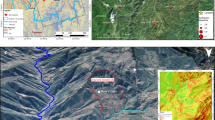Abstract
Terrestrial radar interferometry with its manifold applications offers a great tool to measure the displacements of a slope. Nonetheless, it lacks in significance when it comes to distinguish between deep-situated movements and anthropogenic-induced movements in a densely populated area. This paper gives an approach to estimate displacement patterns and consequently the susceptibility of an active landslide, utilizing radar interferometry measurements, corrected by finite element software and ArcGIS. In the course of YANGTZE Project, a field campaign was carried out in 2013, measuring the overall displacements of the Huangtupo landslide (P.R. China), utilizing a ground-based synthetic aperture radar device. On purpose to calculate the limit of displacements referring to deep-situated movements, a two-dimensional finite element model of a significant geological cross section has been established. Subsequently, a displacement point data set obtained out of the radar interferometry measurements was revised by removing all events exceeding the calculated limit. The corrected data set displays events that are in the range of those, which belong into the margin of values that can refer to deep-situated movements. Finally, a point density map, interpolated out of this data set, shows up areas with a high density of displacements and thus the present displacement pattern during the field investigations. A comparison of this map to already existing GPS and satellite radar interferometry measurements showed up in suitable results of the used method.










Similar content being viewed by others
References
Bi R, Schleier M, Rohn J, Ehret D, Xiang W (2014) Landslide susceptibility analysis based on ArcGIS and artificial neural network for a large catchment in Three Gorges region, China. Environ Earth Sci 72(6):1925–1938. doi:10.1007/s12665-014-3100-5
China Three Gorges Corporation (2014) Three Gorges Project. No. 1 Yuyuantan South Road, Haidian District, Beijing, China. http://www.ctg.com.cn/inc/sqsk.php
Deng QL, Zhu ZY, Cui ZQ, Wang XP (2000) Mass rock creep and landsliding on the Huangtupo slope in the reservoir area of the Three Gorges Project, Yangtze River, China. Eng Geol 58(1):67–83. doi:10.1016/S0013-7952(00)00053-3
Ehret D, Rohn J, Dumperth C, Eckstein S, Ernstberger S, Otte K et al (2010) Frequency ratio analysis of mass movements in the Xiangxi catchment, Three Gorges Reservoir area, China. J Earth Sci 21(6):824–834. doi:10.1007/s12583-010-0134-9
Guanfeng A, Kunlong Y, Huiming T (2002) Discrete element analysis of Huangtupo landslide. J China Univ Geosci 13:83–85
Hubei Survey and Design Institute for Geo-hazard (2001) Survey report of Huangtupo landslide in Three Gorges Reservoir area, BaDong, Hubei Province, China (in Chinese)
Jiang J, Xiang W, Zeng W, Joachim R, Yao Y (2012) Research on the water-rock (soil) interaction mechanism of Huangtupo riverside landslide in Three Gorges Reservoir, Chin J Geot Eng 34(7):1209–1216
Jiang J, Ehret D, Xiang W, Rohn J, Huang L, Yan S, Bi R (2011) Numerical simulation of Qiaotou Landslide deformation caused by drawdown of the Three Gorges Reservoir, China. Environ Earth Sci 62(2):411–419. doi:10.1007/s12665-010-0536-0
Ruff M, Czurda K (2008) Landslide susceptibility analysis with a heuristic approach in the Eastern Alps (Vorarlberg, Austria). Geomorphology 94(3–4):314–324. doi:10.1016/j.geomorph.2006.10.032
Schleier M, Bi R, Rohn J, Ehret D, Xiang W (2014) Robust landslide susceptibility analysis by combination of frequency ratio, heuristic GIS-methods and ground truth evaluation for a mountainous study area with poor data availability in the Three Gorges Reservoir area, PR China. Environ Earth Sci 71(7):3007–3023. doi:10.1007/s12665-013-2677-4
Schönbrodt S, Saumer P, Behrens T, Seeber C, Scholten T (2010) Assessing the USLE crop and management factor C for soil erosion modeling in a large mountainous watershed in Central China. J Earth Sci 21(6):835–845. doi:10.1007/s12583-010-0135-8
Strehmel A, Schönbrodt-Stitt S, Buzzo G, Dumperth C, Stumpf F, Zimmermann K et al (2015) Assessment of geo-hazards in a rapidly changing landscape. The three Gorges Reservoir Region in China. Environ Earth Sci. doi:10.1007/s12665-015-4503-7
Subklew G, Ulrich J, Fürst L, Höltkemeier A (2010) Environmental impacts of the Yangtze Three Gorges Project. An overview of the Chinese-German research cooperation. J Earth Sci 21(6):817–823. doi:10.1007/s12583-010-0133-x
Sun G, Zheng H, Tang H, Dai F (2015) Huangtupo landslide stability under water level fluctuations of the Three Gorges Reservoir. Landslides. doi:10.1007/s10346-015-0637-7
Tantianuparp P, Shi X, Zhang L, Balz T, Liao M (2013) Characterization of landslide deformations in Three Gorges area using multiple InSAR Data Stacks. Remote Sens 5(6):2704–2719. doi:10.3390/rs5062704
Tomas R, Li Z, Liu P, Singleton A, Hoey T, Cheng X (2014) Spatiotemporal characteristics of the Huangtupo landslide in the Three Gorges region (China) constrained by radar Interferom. Geophys J Int 197(1):213–232. doi:10.1093/gji/ggu017
Wang F, Li T (2009) Landslide disaster mitigation in Three Gorges Reservoir, China. 1. Aufl. s.l. Springer (Environmental Science and Engineering). http://site.ebrary.com/lib/alltitles/docDetail.action?docID=10313563
Wang J, Xiang W, Lu N (2014) Landsliding triggered by reservoir operation. A general conceptual model with a case study at Three Gorges Reservoir. Acta Geotech 9(5):771–788. doi:10.1007/s11440-014-0315-2
Xiong W, Qingchun Y, Manchao H, Xin Z, Lili Z (2006) Slide mechanisms of a giant ancient slide body at Huangtupo, Badong County in the Three Gorges Reservior area. In: IAEG2006 (Paper number 790)
Acknowledgments
All studies were carried out as a part of the interdisciplinary “YANGTZE-Project” which is supported by the German Federal Ministry of Education and Research (BMBF). The authors want to thank the BMBF for the financial support. Special thanks go to Prof. Dr. Xiang Wei and his students of China University of Geosciences (Wuhan) for their support and organization while the field trips, as well as to all project partners of YANGTZE Project for their close collaboration.
Author information
Authors and Affiliations
Corresponding author
Additional information
This article is part of a Topical Collection in Environmental Earth Sciences on “Environmental Research of the Three Gorges Reservoir”, guest edited by Binghui Zheng, Shengrui Wang, Yanwen Qin, Stefan Norra, and Xiafu Liu.
Rights and permissions
About this article
Cite this article
Dumperth, C., Rohn, J., Fleer, A. et al. Local-scale assessment of the displacement pattern of a densely populated landslide, utilizing finite element software and terrestrial radar interferometry: a case study on Huangtupo landslide (P.R. China). Environ Earth Sci 75, 880 (2016). https://doi.org/10.1007/s12665-016-5475-y
Received:
Accepted:
Published:
DOI: https://doi.org/10.1007/s12665-016-5475-y




